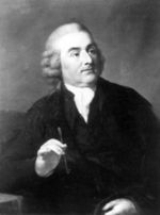
Petrus Camper
Encyclopedia
Peter, Pieter, or usually Petrus Camper (May 11, 1722 in Leiden – April 7, 1789 in The Hague
) was a Dutch
physician
, anatomist, physiologist, midwife, zoologist, anthropologist, paleontologist and a naturalist
. He studied the orangutan
, the rhinoceros
, the skull of a whale
. One of the first to interest himself in comparative anatomy
and paleontology
, he also invented the measure of the facial angle. Camper was not a dull professor in his library, becoming a celebrity in Europe and a member of the Royal Society
. He was interested in architecture
, mathematics
, and made drawing
s for his lectures. He designed and made tools for his patients, always trying to be practical. Besides he was a sculptor, a patron of art and a conservative politician
.
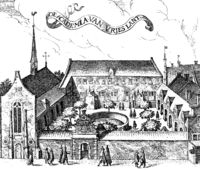 Camper was the son of a local well-to-do minister, who made his fortune in the East Indies
Camper was the son of a local well-to-do minister, who made his fortune in the East Indies
. As a brilliant alumnus, he studied in the University of Leiden medicine, philosophy, and got a degree in both sciences on the same day at 24. His professors included Pieter van Musschenbroek
and Willem Jacob 's Gravesande for physics and mathematics, Herman Boerhaave
and Hieronymus David Gaubius
for medicine; François Hemsterhuis
for philosophy. After both his parents died then traveled in 1748 to Prussia
, England
, where he met with William Smellie
, France
and Switzerland
. He was offered sundry professorships, being first named professor of philosophy, anatomy and surgery
in 1750 in the University of Franeker
. Camper married the young and rich widow of a burgomaster from Harlingen
.
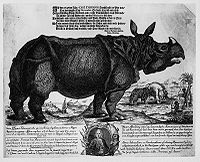 Starting in 1755, he resided in Amsterdam where he occupied a chair of anatomy and surgery at the Athenaeum Illustre, later completed by a medicine chair. He investigated inguinal hernia
Starting in 1755, he resided in Amsterdam where he occupied a chair of anatomy and surgery at the Athenaeum Illustre, later completed by a medicine chair. He investigated inguinal hernia
, patella and the best form of shoe. He withdraw five years later to dedicate himself to scientific research and lived on the property, just outside Franeker. In 1762 he became political active, a year later he chose, to accept the chair of anatomy, surgery and botanics at the University of Groningen
. Camper started a surgical clinic and showed selfmade drawings to illustrate his eloquent lectures, before retiring in 1773. His attention was for zoology and his collection of mineral
s and fossil
s.
Among his many works, he studied osteology
of birds and discovered the presence of air in the inner cavities of birds' skeletons. He interested himself to the anatomy of eight orangutan
s, demonstrating against contemporary theories that it was a different species from the human being
, and not simply a "degenerate" type of human. Petrus Camper published memoirs on hearing of fishes, the sound of frogs, investigated an elephant
, and a rhinoceros from Java. He studied the rinderpest
, rabid
s.
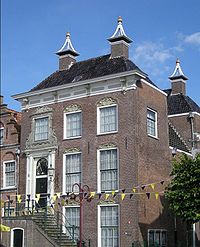
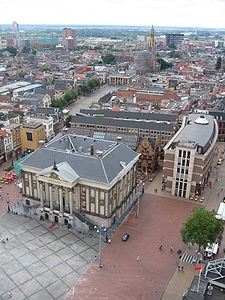 One of the first scholar to study comparative anatomy
One of the first scholar to study comparative anatomy
, Petrus Camper demonstrated the principle of correlation in all organisms by the mechanical exercise he called a "metamorphosis". In his 1778 lecture, "On the Points of Similarity between the Human Species, Quadrupeds, Birds, and Fish; with Rules for Drawing, founded on this Similarity," he metamorphosed a horse into a human being, thus showing the similarity between all vertebrates. Étienne Geoffroy Saint-Hilaire
(1772–1884) theorized this in 1795 as the "unity of organic composition," the influence of which is perceptible in all his subsequent writings; nature, he observed, presents us with only one plan of construction, the same in principle, but varied in its accessory parts. Camper's metamorphoses which demonstrated this "unity of Plan" greatly impressed Diderot
and Goethe. In 1923 and 1939 some Dutch authors suggested that Camper foreshadowed Goethe's famous idea of "type" — a common structural pattern in some manner
to the ear
; and the other perpendicularly from the advancing part of the upper jawbone
to the most prominent part of the forehead
. He claimed that antique Greco-Roman statues presented an angle of 100°-95°, Europeans of 90°, 'Orientals' of 80°, Black people of 70° and the orangutan of 58°, but not in an overtly racist fashion-he merely claimed that, out of all human races, Africans were most removed from the Classical sense of ideal beauty. These results were later used as scientific racism, with research continued by Étienne Geoffroy Saint-Hilaire
(1772–1844) and Paul Broca
(1824–1880).
Camper, however, agreed with Buffon in drawing a sharp line between human and animals (although he was misinterpreted by Diderot, who claimed that he was a supporter of the Great Chain of Being
theory) .
(1769–1832) praised his "genius eye" but criticized him for keeping himself to simple sketches ("Camper porta, pour ainsi dire en passant, le coup d'œil du génie sur une foule d'objets intéressants, mais presque tous ses travaux ne furent que des ébauches"). Petrus Camper's main works were:
In 1888, the son of the last female descendant of Petrus Camper petitioned the Dutch crown for a name change to honor his mother, Theodora Aurelia Louisa Camper (1821–1890). The petition was granted by Royal Decree No. 15; and the descendants of Abraham Adriaan Aurelius Gerard Camper-Titsingh Sr. (1845–1910) and Abraham Adriaan Aurelius Gerard Camper-Titsingh Jr. (1889–1974) live today in the United States.
The Dutch author, Thomas Rosenboom, used Petrus Camper as a character in his novel, Gewassen vlees (1994).
The Hague
The Hague is the capital city of the province of South Holland in the Netherlands. With a population of 500,000 inhabitants , it is the third largest city of the Netherlands, after Amsterdam and Rotterdam...
) was a Dutch
Netherlands
The Netherlands is a constituent country of the Kingdom of the Netherlands, located mainly in North-West Europe and with several islands in the Caribbean. Mainland Netherlands borders the North Sea to the north and west, Belgium to the south, and Germany to the east, and shares maritime borders...
physician
Physician
A physician is a health care provider who practices the profession of medicine, which is concerned with promoting, maintaining or restoring human health through the study, diagnosis, and treatment of disease, injury and other physical and mental impairments...
, anatomist, physiologist, midwife, zoologist, anthropologist, paleontologist and a naturalist
Natural history
Natural history is the scientific research of plants or animals, leaning more towards observational rather than experimental methods of study, and encompasses more research published in magazines than in academic journals. Grouped among the natural sciences, natural history is the systematic study...
. He studied the orangutan
Orangutan
Orangutans are the only exclusively Asian genus of extant great ape. The largest living arboreal animals, they have proportionally longer arms than the other, more terrestrial, great apes. They are among the most intelligent primates and use a variety of sophisticated tools, also making sleeping...
, the rhinoceros
Rhinoceros
Rhinoceros , also known as rhino, is a group of five extant species of odd-toed ungulates in the family Rhinocerotidae. Two of these species are native to Africa and three to southern Asia....
, the skull of a whale
Whale
Whale is the common name for various marine mammals of the order Cetacea. The term whale sometimes refers to all cetaceans, but more often it excludes dolphins and porpoises, which belong to suborder Odontoceti . This suborder also includes the sperm whale, killer whale, pilot whale, and beluga...
. One of the first to interest himself in comparative anatomy
Comparative anatomy
Comparative anatomy is the study of similarities and differences in the anatomy of organisms. It is closely related to evolutionary biology and phylogeny .-Description:...
and paleontology
Paleontology
Paleontology "old, ancient", ὄν, ὀντ- "being, creature", and λόγος "speech, thought") is the study of prehistoric life. It includes the study of fossils to determine organisms' evolution and interactions with each other and their environments...
, he also invented the measure of the facial angle. Camper was not a dull professor in his library, becoming a celebrity in Europe and a member of the Royal Society
Royal Society
The Royal Society of London for Improving Natural Knowledge, known simply as the Royal Society, is a learned society for science, and is possibly the oldest such society in existence. Founded in November 1660, it was granted a Royal Charter by King Charles II as the "Royal Society of London"...
. He was interested in architecture
Architecture
Architecture is both the process and product of planning, designing and construction. Architectural works, in the material form of buildings, are often perceived as cultural and political symbols and as works of art...
, mathematics
Mathematics
Mathematics is the study of quantity, space, structure, and change. Mathematicians seek out patterns and formulate new conjectures. Mathematicians resolve the truth or falsity of conjectures by mathematical proofs, which are arguments sufficient to convince other mathematicians of their validity...
, and made drawing
Drawing
Drawing is a form of visual art that makes use of any number of drawing instruments to mark a two-dimensional medium. Common instruments include graphite pencils, pen and ink, inked brushes, wax color pencils, crayons, charcoal, chalk, pastels, markers, styluses, and various metals .An artist who...
s for his lectures. He designed and made tools for his patients, always trying to be practical. Besides he was a sculptor, a patron of art and a conservative politician
Politician
A politician, political leader, or political figure is an individual who is involved in influencing public policy and decision making...
.
Studies and teaching

East Indies
East Indies is a term used by Europeans from the 16th century onwards to identify what is now known as Indian subcontinent or South Asia, Southeastern Asia, and the islands of Oceania, including the Malay Archipelago and the Philippines...
. As a brilliant alumnus, he studied in the University of Leiden medicine, philosophy, and got a degree in both sciences on the same day at 24. His professors included Pieter van Musschenbroek
Pieter van Musschenbroek
Pieter van Musschenbroek was a Dutch scientist. He was a professor in Duisburg, Utrecht, and Leiden, where he held positions in mathematics, philosophy, medicine, and astrology. He is credited with the invention of the first capacitor in 1746: the Leyden jar. He performed pioneering work on the...
and Willem Jacob 's Gravesande for physics and mathematics, Herman Boerhaave
Herman Boerhaave
Herman Boerhaave was a Dutch botanist, humanist and physician of European fame. He is regarded as the founder of clinical teaching and of the modern academic hospital. His main achievement was to demonstrate the relation of symptoms to lesions...
and Hieronymus David Gaubius
Hieronymus David Gaubius
Hieronymus David Gaubius was a German physician and chemist.-Life:He was a native of Heidelberg. He studied medicine and sciences at the Universities of Harderwijk and Leiden, where he was a pupil of Hermann Boerhaave and Bernhard Siegfried Albinus...
for medicine; François Hemsterhuis
François Hemsterhuis
François Hemsterhuis was a Dutch writer on aesthetics and moral philosophy.The son of Tiberius Hemsterhuis, he was born at Franeker in the Netherlands. He was educated at the University of Leiden, where he studied Plato...
for philosophy. After both his parents died then traveled in 1748 to Prussia
Prussia
Prussia was a German kingdom and historic state originating out of the Duchy of Prussia and the Margraviate of Brandenburg. For centuries, the House of Hohenzollern ruled Prussia, successfully expanding its size by way of an unusually well-organized and effective army. Prussia shaped the history...
, England
England
England is a country that is part of the United Kingdom. It shares land borders with Scotland to the north and Wales to the west; the Irish Sea is to the north west, the Celtic Sea to the south west, with the North Sea to the east and the English Channel to the south separating it from continental...
, where he met with William Smellie
William Smellie
William Smellie may refer to:*William Smellie , Scottish encyclopedist*William Smellie , obstetrician and the "father of British midwifery"...
, France
France
The French Republic , The French Republic , The French Republic , (commonly known as France , is a unitary semi-presidential republic in Western Europe with several overseas territories and islands located on other continents and in the Indian, Pacific, and Atlantic oceans. Metropolitan France...
and Switzerland
Switzerland
Switzerland name of one of the Swiss cantons. ; ; ; or ), in its full name the Swiss Confederation , is a federal republic consisting of 26 cantons, with Bern as the seat of the federal authorities. The country is situated in Western Europe,Or Central Europe depending on the definition....
. He was offered sundry professorships, being first named professor of philosophy, anatomy and surgery
Surgery
Surgery is an ancient medical specialty that uses operative manual and instrumental techniques on a patient to investigate and/or treat a pathological condition such as disease or injury, or to help improve bodily function or appearance.An act of performing surgery may be called a surgical...
in 1750 in the University of Franeker
University of Franeker
The University of Franeker was a university in Franeker, Friesland, presently part of the Netherlands. It was the second oldest university of the Netherlands, founded shortly after Leiden University....
. Camper married the young and rich widow of a burgomaster from Harlingen
Harlingen, Netherlands
Harlingen is a municipality and a city in the northern Netherlands, in the province of Friesland at the Wadden Sea. Harlingen is an old town with a long history of fishing and shipping....
.

Inguinal hernia
An inguinal hernia is a protrusion of abdominal-cavity contents through the inguinal canal. They are very common , and their repair is one of the most frequently performed surgical operations....
, patella and the best form of shoe. He withdraw five years later to dedicate himself to scientific research and lived on the property, just outside Franeker. In 1762 he became political active, a year later he chose, to accept the chair of anatomy, surgery and botanics at the University of Groningen
University of Groningen
The University of Groningen , located in the city of Groningen, was founded in 1614. It is one of the oldest universities in the Netherlands as well as one of its largest. Since its inception more than 100,000 students have graduated...
. Camper started a surgical clinic and showed selfmade drawings to illustrate his eloquent lectures, before retiring in 1773. His attention was for zoology and his collection of mineral
Mineral
A mineral is a naturally occurring solid chemical substance formed through biogeochemical processes, having characteristic chemical composition, highly ordered atomic structure, and specific physical properties. By comparison, a rock is an aggregate of minerals and/or mineraloids and does not...
s and fossil
Fossil
Fossils are the preserved remains or traces of animals , plants, and other organisms from the remote past...
s.
Among his many works, he studied osteology
Osteology
Osteology is the scientific study of bones. A subdiscipline of anatomy, anthropology, and archeology, osteology is a detailed study of the structure of bones, skeletal elements, teeth, morphology, function, disease, pathology, the process of ossification , the resistance and hardness of bones , etc...
of birds and discovered the presence of air in the inner cavities of birds' skeletons. He interested himself to the anatomy of eight orangutan
Orangutan
Orangutans are the only exclusively Asian genus of extant great ape. The largest living arboreal animals, they have proportionally longer arms than the other, more terrestrial, great apes. They are among the most intelligent primates and use a variety of sophisticated tools, also making sleeping...
s, demonstrating against contemporary theories that it was a different species from the human being
Human
Humans are the only living species in the Homo genus...
, and not simply a "degenerate" type of human. Petrus Camper published memoirs on hearing of fishes, the sound of frogs, investigated an elephant
Elephant
Elephants are large land mammals in two extant genera of the family Elephantidae: Elephas and Loxodonta, with the third genus Mammuthus extinct...
, and a rhinoceros from Java. He studied the rinderpest
Rinderpest
Rinderpest was an infectious viral disease of cattle, domestic buffalo, and some other species of even-toed ungulates, including buffaloes, large antelopes and deer, giraffes, wildebeests and warthogs. After a global eradication campaign, the last confirmed case of rinderpest was diagnosed in 2001...
, rabid
Rabid
Rabid is a 1977 horror film written and directed by David Cronenberg. It features Marilyn Chambers in the lead role, supported by Frank Moore, Howard Ryshpan, Joe Silver and Robert A...
s.

- He was visited by Samuel Thomas von SömmeringSamuel Thomas von SömmeringSamuel Thomas von Sömmerring was a German physician, anatomist, anthropologist, paleontologist and inventor. Sömmerring discovered the macula in the retina of the human eye...
, who later became professor in GöttingenGöttingenGöttingen is a university town in Lower Saxony, Germany. It is the capital of the district of Göttingen. The Leine river runs through the town. In 2006 the population was 129,686.-General information:...
. - He became an associate of the French Academy of SciencesFrench Academy of SciencesThe French Academy of Sciences is a learned society, founded in 1666 by Louis XIV at the suggestion of Jean-Baptiste Colbert, to encourage and protect the spirit of French scientific research...
and had a eulogy in his honour composed by Nicolas de Condorcet and Félix Vicq-d'AzyrFélix Vicq-d'AzyrFélix Vicq d'Azyr was a French physician and anatomist, the originator of comparative anatomy and discoverer of the theory of homology in biology.-Biography:Vicq d'Azyr was born in Valognes, Normandy, the son of a physician...
. - In 1776 he became involved in a plan of dike construction.
- In 1780 he took lessons from Étienne Maurice FalconetÉtienne Maurice FalconetÉtienne Maurice Falconet is counted among the first rank of French Rococo sculptors, whose patron was Mme de Pompadour.-Life:Falconet was born to a poor family in Paris...
. - In his ideas about art Camper was influenced by Johann Joachim WinckelmannJohann Joachim WinckelmannJohann Joachim Winckelmann was a German art historian and archaeologist. He was a pioneering Hellenist who first articulated the difference between Greek, Greco-Roman and Roman art...
. - He made drawings of the DolmenDolmenA dolmen—also known as a portal tomb, portal grave, dolmain , cromlech , anta , Hünengrab/Hünenbett , Adamra , Ispun , Hunebed , dös , goindol or quoit—is a type of single-chamber megalithic tomb, usually consisting of...
south of Groningen. - He was in the selection committee for the new townhall in Groningen.
- He became one of the directors of the Admiralty of FrieslandAdmiralty of FrieslandThe Admiralty of Friesland or Frisian Admiralty was one of the five admiralties of the Dutch Republic...
. - He was appointed as an (OrangistOrangism (Netherlands)Orangism is a monarchist political support for the House of Orange-Nassau as monarchy of the Netherlands. It played a significant role in the political history of the Netherlands since the Dutch revolt...
) burgomasterBurgomasterBurgomaster is the English form of various terms in or derived from Germanic languages for the chief magistrate or chairman of the executive council of a sub-national level of administration...
of WorkumWorkumWorkum is the largest town of Nijefurd in Friesland. It received city rights in 1374. It lies within the municipality of Nijefurd. Currently has around 4000 inhabitants....
in 1783, opposing the Patriots (faction)Patriots (faction)The Patriots were a political faction in the Dutch Republic in the second half of the 18th century. They were led by Joan van der Capellen tot den Pol, gaining power from November 1782....
. - In September 1787 he became the president of the state councilDutch Council of StateIn the Netherlands, the Council of State is a constitutionally established advisory body to the government which consists of members of the royal family and Crown-appointed members generally having political, commercial, diplomatic, or military experience...
of the Dutch RepublicDutch RepublicThe Dutch Republic — officially known as the Republic of the Seven United Netherlands , the Republic of the United Netherlands, or the Republic of the Seven United Provinces — was a republic in Europe existing from 1581 to 1795, preceding the Batavian Republic and ultimately...
and warmly welcomed the stattholder William V of Orange and his wife Wilhelmine of Prussia. - At the end of life he suffered from pleuritis, Camper drank a good glass of champagne and died.
Comparative anatomy

Comparative anatomy
Comparative anatomy is the study of similarities and differences in the anatomy of organisms. It is closely related to evolutionary biology and phylogeny .-Description:...
, Petrus Camper demonstrated the principle of correlation in all organisms by the mechanical exercise he called a "metamorphosis". In his 1778 lecture, "On the Points of Similarity between the Human Species, Quadrupeds, Birds, and Fish; with Rules for Drawing, founded on this Similarity," he metamorphosed a horse into a human being, thus showing the similarity between all vertebrates. Étienne Geoffroy Saint-Hilaire
Étienne Geoffroy Saint-Hilaire
Étienne Geoffroy Saint-Hilaire was a French naturalist who established the principle of "unity of composition". He was a colleague of Jean-Baptiste Lamarck and expanded and defended Lamarck's evolutionary theories...
(1772–1884) theorized this in 1795 as the "unity of organic composition," the influence of which is perceptible in all his subsequent writings; nature, he observed, presents us with only one plan of construction, the same in principle, but varied in its accessory parts. Camper's metamorphoses which demonstrated this "unity of Plan" greatly impressed Diderot
Denis Diderot
Denis Diderot was a French philosopher, art critic, and writer. He was a prominent person during the Enlightenment and is best known for serving as co-founder and chief editor of and contributor to the Encyclopédie....
and Goethe. In 1923 and 1939 some Dutch authors suggested that Camper foreshadowed Goethe's famous idea of "type" — a common structural pattern in some manner
"Facial angle"
Petrus Camper is also known for his theory of the "facial angle" originally in connection with beauty. He was concerned with the fact that all artists painted the black Magus in the nativity with Caucasian face. He determined that modern humans had facial angles between 70° and 90°, with African angles closer to 70°. According to this technique, an angle is formed by drawing two lines: one horizontally from the nostrilNostril
A nostril is one of the two channels of the nose, from the point where they bifurcate to the external opening. In birds and mammals, they contain branched bones or cartilages called turbinates, whose function is to warm air on inhalation and remove moisture on exhalation...
to the ear
Ear
The ear is the organ that detects sound. It not only receives sound, but also aids in balance and body position. The ear is part of the auditory system....
; and the other perpendicularly from the advancing part of the upper jawbone
Jawbone
Jawbone can refer to the following:* Mandible, the lower jaw bone* Maxilla, the upper jaw bone of humans* Jawbone , a musical instrument made from the jawbone of a donkey, horse, or zebra* Jawbone , blues musician Bob Zabor...
to the most prominent part of the forehead
Forehead
For the Arsenal striker see GervinhoIn human anatomy, the forehead is the fore part of the head. It is, formally, an area of the head bounded by three features, two of the skull and one of the scalp. The top of the forehead is marked by the hairline, the edge of the area where hair on the scalp...
. He claimed that antique Greco-Roman statues presented an angle of 100°-95°, Europeans of 90°, 'Orientals' of 80°, Black people of 70° and the orangutan of 58°, but not in an overtly racist fashion-he merely claimed that, out of all human races, Africans were most removed from the Classical sense of ideal beauty. These results were later used as scientific racism, with research continued by Étienne Geoffroy Saint-Hilaire
Étienne Geoffroy Saint-Hilaire
Étienne Geoffroy Saint-Hilaire was a French naturalist who established the principle of "unity of composition". He was a colleague of Jean-Baptiste Lamarck and expanded and defended Lamarck's evolutionary theories...
(1772–1844) and Paul Broca
Paul Broca
Pierre Paul Broca was a French physician, surgeon, anatomist, and anthropologist. He was born in Sainte-Foy-la-Grande, Gironde. He is best known for his research on Broca's area, a region of the frontal lobe that has been named after him. Broca’s Area is responsible for articulated language...
(1824–1880).
Camper, however, agreed with Buffon in drawing a sharp line between human and animals (although he was misinterpreted by Diderot, who claimed that he was a supporter of the Great Chain of Being
Great chain of being
The great chain of being , is a Christian concept detailing a strict, religious hierarchical structure of all matter and life, believed to have been decreed by the Christian God.-Divisions:...
theory) .
Legacy
Georges CuvierGeorges Cuvier
Georges Chrétien Léopold Dagobert Cuvier or Jean Léopold Nicolas Frédéric Cuvier , known as Georges Cuvier, was a French naturalist and zoologist...
(1769–1832) praised his "genius eye" but criticized him for keeping himself to simple sketches ("Camper porta, pour ainsi dire en passant, le coup d'œil du génie sur une foule d'objets intéressants, mais presque tous ses travaux ne furent que des ébauches"). Petrus Camper's main works were:
- Démonstrations anatomicx-pathologicœ, AmsterdamAmsterdamAmsterdam is the largest city and the capital of the Netherlands. The current position of Amsterdam as capital city of the Kingdom of the Netherlands is governed by the constitution of August 24, 1815 and its successors. Amsterdam has a population of 783,364 within city limits, an urban population...
, 1760–1762 ; - Dissertation sur les différences des traits du visage ;
- Discours sur l'art de juger les passions de l'homme par les traits de son visage ;
- Dissertation sur les variétés naturelles de l'espèce humaine.
In 1888, the son of the last female descendant of Petrus Camper petitioned the Dutch crown for a name change to honor his mother, Theodora Aurelia Louisa Camper (1821–1890). The petition was granted by Royal Decree No. 15; and the descendants of Abraham Adriaan Aurelius Gerard Camper-Titsingh Sr. (1845–1910) and Abraham Adriaan Aurelius Gerard Camper-Titsingh Jr. (1889–1974) live today in the United States.
The Dutch author, Thomas Rosenboom, used Petrus Camper as a character in his novel, Gewassen vlees (1994).
Works
- Demonstrationes anatomico- pathologicae [1760-1762]
- On the Best Form of Shoe
- On the Points of Similarity between the Human Species, Quadrupeds, Birds, and Fish; with Rules for Drawing, founded on this Similarity (1778)
- Historiae literariae cultoribus S.P.D. Petrus Camper. A list of his work, published by him self.
- Works on natural history, a translation of Camper's work, published by Hendrik Jansen in 1803 in three in-octavo volumes.
External links
- http://www.whonamedit.com/doctor.cfm/3231.html
- Rijksuniversiteit Groningen
- Painting by Tibout Regters with Camper and colleagues in the Guild
- University of Groningen on Camper
See also
- Comparative anatomyComparative anatomyComparative anatomy is the study of similarities and differences in the anatomy of organisms. It is closely related to evolutionary biology and phylogeny .-Description:...
- Craniometry
- Scientific racismScientific racismScientific racism is the use of scientific techniques and hypotheses to sanction the belief in racial superiority or racism.This is not the same as using scientific findings and the scientific method to investigate differences among the humans and argue that there are races...

